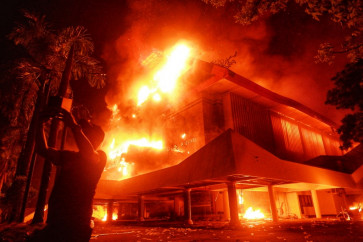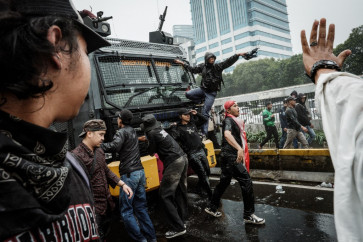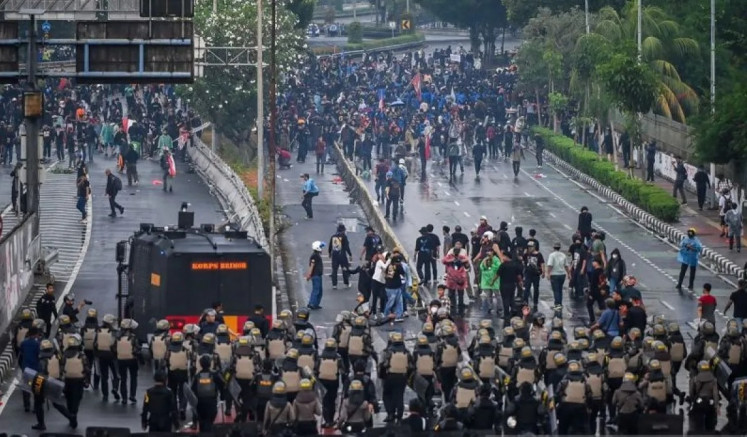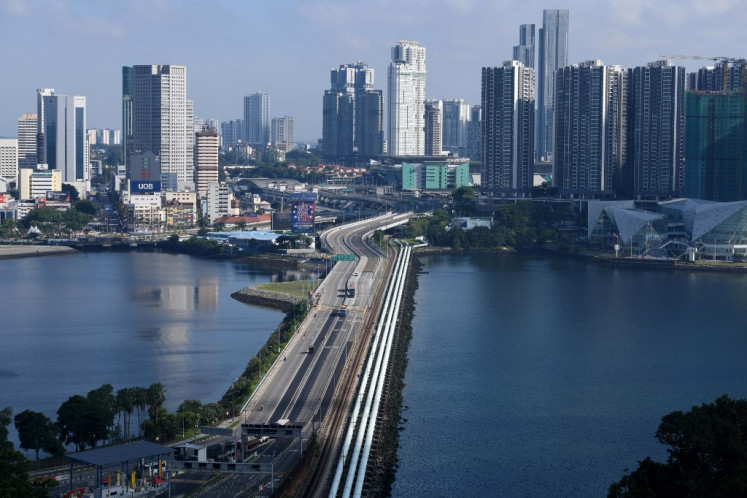Popular Reads
Top Results
Can't find what you're looking for?
View all search resultsPopular Reads
Top Results
Can't find what you're looking for?
View all search resultsNew climate chapter for Indonesia
The fact that 50 million Indonesians live with limited or no access to modern energy services provides an opportunity to shift toward renewable energy while addressing the urgent challenge.
Change text size
Gift Premium Articles
to Anyone
 President Joko “Jokowi” Widodo (center) inspect the solar photovoltaic power plant Daruba in Juanga village, South Morotai in Maluku on Wednesday, as part of his eastern Indonesian tour. The President is also scheduled to inaugurate five seaports in the province in the same day. (Antara/Yudhi Mahatma)
President Joko “Jokowi” Widodo (center) inspect the solar photovoltaic power plant Daruba in Juanga village, South Morotai in Maluku on Wednesday, as part of his eastern Indonesian tour. The President is also scheduled to inaugurate five seaports in the province in the same day. (Antara/Yudhi Mahatma)
“As a country that hosts one of the largest forests in the world, Indonesia has decided to become part of the solution,” President Joko “Jokowi” Widodo said in his speech at COP 21 in Paris last December. To become “part of the solution”, Indonesia committed unconditionally to reducing its emissions by almost a third ( 29 percent ) from a 2030 business-as-usual scenario, or by up to 41 percent if certain international assistance was made available.
On April 22, the historic Paris Agreement will be signed in New York, cueing the world’s sixth-largest emitter to start walking the talk.
Ahead of this signing, Environment and Forestry Minister Siti Nurbaya made an encouraging statement about how Indonesia’s Nationally Determined Contribution ( NDC ) should be an enhanced and more ambitious version of the climate goal submitted to the UN, known as the INDC, or Intended Nationally Determined Contribution ( INDC ).
To realize her vision of “guiding the nation to transform into a low-carbon developer” as a signatory to the Paris Agreement, Indonesia needs to ensure that there is strong national ownership of the task and successful ratification of the agreement.
Beyond shaking hands, it is also important to understand what achieving these climate targets entails. While recent analysis pointed out that 21 countries managed to decouple economic growth from emissions in 2000 to 2014, Indonesia has yet to identify when its emissions will peak, let alone the national roadmap for getting there.
On the hazy horizon, however, there are four things we can be certain about regarding Indonesia’s climate action:
( 1 ) Land and energy sectors serve as the backbone of mitigation efforts. Land-based and energy-based emissions contributed up to 90 percent of Indonesia’s total greenhouse gas emissions in 2010 and are responsible for that much of its projected emissions in 2030.
That said, contrary to popular belief that Indonesia should prioritize its forestry sector, safeguarding both these sectors in parallel is vital for accomplishing the country’s climate goals.
In its INDC, Indonesia highlighted peatland restoration and sustainable land-use management, along with accelerated renewable energy development, as its main vehicles for progress toward significant emissions cuts.
However, questions remain regarding how these targets will be achieved.
( 2 ) Meeting the unconditional requires holistic transformation of our energy sector. An analysis of emissions reduction targets in each sector by the National Development Planning Agency ( Bappenas ) shows that most additional emissions reductions in the conditional scenario will be energy based.
Thus, the Energy and Mineral Resources Ministry and private energy entities may hold the aces when it comes to accomplishing Indonesia’s ambitious target of 41 percent reduction against a business-as-usual scenario.
The establishment of the Center of Excellence for Clean Energy, that seeks to accelerate and facilitate clean energy initiatives in Indonesia while greening the current electricity grid, is an important milestone and steers in the right direction.
The fact that 50 million Indonesians live with limited or no access to modern energy services provides an opportunity to shift toward renewable energy while addressing the urgent challenge.
Although existing programs for reaching 100 percent electrification nationally — including the heavily coal-based 35-gigawatt power plant development — are tactical in the short term, they could lock Indonesia into a high-carbon energy sector in the long term.
Hence, shifting to more mini-grid and off-grid renewable energies in Indonesia’s most remote areas, while optimizing energy mix modelling, should be done immediately. Coupled with concrete and active demand-management policies, this approach would help Indonesia achieve a significant reduction in emissions.
( 3 ) Meanwhile, Indonesia’s forests still provide the “low-hanging fruit”. Since a severe forest and peat fires episode hit Indonesia in 2015, the country has been under a lot of pressure to manage its land use more sustainably. Indeed, Indonesia bases 65 percent of its unconditional reductions on agriculture, forestry and other land use and peat management mitigation efforts, demonstrating that land-based activities still provide most emissions reduction potential.
Extending a moratorium to cover not only primary forests and peatland but also secondary forests, revoking existing concession permits for undeveloped forest and restoring 2 million hectares of peatland and 12.7 million hectares of unproductive lands, are some of the actions that could help Indonesia achieve its reduction target.
( 4 ) Horizontal synergy and vertical coordination are foundational. Lastly and most importantly, President Jokowi needs to put in place good climate governance that is founded on a robust synergy between ministries and strong coordination between subnational governments.
Since climate change is a broad issue that involves many varied elements, working strictly based on mandates, tasks and functions ( tupoksi ) could pose a significant risk that would slow down Indonesia’s progress toward its climate goals.
Indonesia’s biofuel target is an instance where land-based and energy-based ministries need to work together to meet goals without sacrificing the country’s remaining intact forests.
Concurrently, subnational governments could benefit from national assistance in working toward their respective emissions reduction goals.
The making available of provincial climate data, in particular, could provide insights that would help the central government as well as other relevant actors provide effective technical assistance and capacity building for local agencies.
While signing the Paris Agreement opens up a new climate chapter for Indonesia, understanding these four key aspects is also an indispensable step that would help Indonesia avoid future obstacles in implementing its climate plans.
***
Andhyta Firselly Utami is a research analyst, Arief Wijaya a climate and forest associate and Almo Pradana a climate and energy associate, all at the World Resources Institute Indonesia ( WRI ) in Jakarta.
---------------
We are looking for information, opinions, and in-depth analysis from experts or scholars in a variety of fields. We choose articles based on facts or opinions about general news, as well as quality analysis and commentary about Indonesia or international events. Send your piece to community@jakpost.com.









